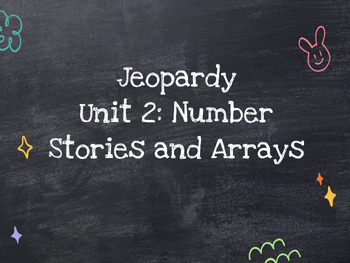Jeopardy Review: Everyday Math Unit 2: Third Grade
Kelsey White
1 Follower
Grade Levels
3rd
Subjects
Resource Type
Standards
CCSS3.MD.A.1
CCSS3.NBT.A.1
CCSS3.NBT.A.2
CCSS3.OA.A.1
CCSS3.OA.A.2
Formats Included
- Google Slides™
Pages
54 pages
Kelsey White
1 Follower

Made for Google Drive™
This resource can be used by students on Google Drive or Google Classroom. To access this resource, you’ll need to allow TPT to add it to your Google Drive. See our FAQ and Privacy Policy for more information.
Description
Need a fun way to review Everyday Math assessments with your third graders? Try Jeopardy! This slideshow contains scaffolded questions for each topic in Unit 2: Number Stories and Arrays. Your students will have a blast and ace the test. (:
This slideshow contains:
-25 review questions aligned to Everyday Math Unit 2
-An interactive board (clickable!)
-A slide at the end to project separately to keep track of which questions have been chosen and team points!
Thank you! I am in the process of making Jeopardy games for the other Everyday Math Units for third grade. Other grade levels will be coming soon!
Total Pages
54 pages
Answer Key
Included
Teaching Duration
N/A
Report this resource to TPT
Reported resources will be reviewed by our team. Report this resource to let us know if this resource violates TPT’s content guidelines.
Standards
to see state-specific standards (only available in the US).
CCSS3.MD.A.1
Tell and write time to the nearest minute and measure time intervals in minutes. Solve word problems involving addition and subtraction of time intervals in minutes, e.g., by representing the problem on a number line diagram.
CCSS3.NBT.A.1
Use place value understanding to round whole numbers to the nearest 10 or 100.
CCSS3.NBT.A.2
Fluently add and subtract within 1000 using strategies and algorithms based on place value, properties of operations, and/or the relationship between addition and subtraction.
CCSS3.OA.A.1
Interpret products of whole numbers, e.g., interpret 5 × 7 as the total number of objects in 5 groups of 7 objects each. For example, describe a context in which a total number of objects can be expressed as 5 × 7.
CCSS3.OA.A.2
Interpret whole-number quotients of whole numbers, e.g., interpret 56 ÷ 8 as the number of objects in each share when 56 objects are partitioned equally into 8 shares, or as a number of shares when 56 objects are partitioned into equal shares of 8 objects each. For example, describe a context in which a number of shares or a number of groups can be expressed as 56 ÷ 8.


